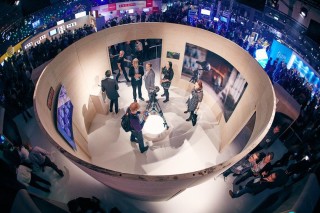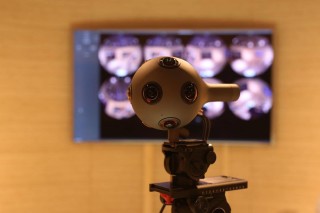The NFL Draft culminated this weekend with 253 prospects being selected. All of them—including a slew of undrafted ones that later found a home—fulfilled lifelong dreams. Some are preordained franchise saviors. Most will be forgotten names a year from now.
Brands like Visa used the stage to film 360-degree virtual reality videos with prospects like Paxton Lynch, Braxton Miller, Shaq Lawson and Jaylon Smith.
Then there was North Dakota State football quarterback Carson Wentz. Wentz became one of the greater gambles in recent draft history when the Eagles traded up to the No. 2 overall pick to snag him because the signal-caller’s skill set is largely unproven against supreme competition. Being born and raised in Bismarck, he’s largely an unknown person outside state lines, too.
What better way to introduce a franchise quarterback to fans than through cross-platform storytelling, right? That’s exactly what ESPN did, giving Wentz a coming out party of sorts by featuring him on the cover of ESPN The Magazine and also across TV and social media through the television network’s first 360-degree video segment.
ESPN used Nokia’s new VR camera Ozo to capture the quarterback prior to him being drafted. It was one of the first pieces shot with Ozo. “It was a cool experience—definitely different, but enjoyable,” Wentz said, per Fortune. “I believe it will be very cool to watch and see exactly how the camera captures everything around it.”
VR and 360-degree video has quickly developed into a new frontier for experimental storytelling ranging from legacy brands to traditional journalistic institutions toiling in the medium. To keep up with the waves of innovators knocking on content’s doors, equipment is maturing faster than first projected in order to enable an industry. Tally this as another win for the “immersive entertainment experiences” column.
Launched last November, the Ozo is the latest VR camera aimed at professional content creators. It allows real-time 3D viewing, with an innovative playback solution that removes the need to pre-assemble a panoramic image.
Shaped like the size of a human head, the futuristic Ozo is dressed with eight lenses and microphones. Each lens is separated by the equivalent distance of a person’s eyes; it’s designed to mimic what humans are able to see, and hear. Each lens has a 195-degree field view, 2Kx2K resolution per eye, and shoots 30 frames per second. It was made available in the European market in March. Priced at $60,000, it’s a sizable statement for Nokia to announce a return into the hardware since selling the handset unit to Microsoft. Last week, Nokia and Walt Disney Studios struck a deal designed to give Disney marketers and filmmakers the tools they need to create engaging VR content via access to the Ozo.
Stuart English, who’s responsible for worldwide sales development for the OZO, joined [a]listdaily at the Silicon Valley Virtual Reality Expo in San Jose, California to talk about Nokia’s newest technology.

When you think of Nokia, you don’t associate it with VR. Why was Ozo introduced to the market?
Nokia is over 100 years old. It was a paper mill company, originally. What do you do with paper? Communicate. And what’s Nokia probably still best known for? Cell phones. What do you do with those? Communicate. Nokia is in the communications business. We look at VR and basically say ‘this is a medium that’s the next phase in communication.’ We believe we have some core technologies we’ve learned in the cell phone business and are applying it to the VR industry as well. This is the future of audio and visual communication. But, fundamentally, we believe we can make money with it.
Ozo is a ground-up redesign for what’s referred to as telepresence VR. The concept of telepresence is that we can take you from where you are right now, and relocate you to another location that you couldn’t otherwise be. When we designed the Ozo, we looked at the current technology and converted that. You can’t get to the point you need to be from building a camera based upon a rig-based concept. You have to do a ground-up design. When you look at the Ozo, it’s very clear that it’s different. By having eight cameras around the ball, it means that we can virtually look between pairs of cameras and see the world like humans. It delivers a very natural stereoscopic visual viewpoint.
How are you trying to build awareness and increase sales? What’s your pitch?
Sales are actually going very well since shipments started late March, primarily in Los Angeles because that’s the storytelling capital. The way the camera tends to get sold is through specialized resellers. We have three resellers in L.A., and two in New York. It’s not at a consumer price point. If we take a look at cinema-like cameras, there are DSLR-types consumers can buy. But the guys who actually make movies, they use cameras that are $60,000-to-$100,000. The reasons they use those—yes, picture quality—but those are professional tools they can rely on, and they actually make the creation of content very efficient. It lets them monitor what they’re shooting on set. If you don’t use professional-level tools making professional content, it will cost you more money. You’ll lose efficiency on set, and spend more time in post production. Anything you might think you’re saving in equipment costs you’re getting straight back in operational costs. Ozo takes care of that.

Who is your target customer?
VR does not imply consumer-level cameras. What VR implies is consumer-level consumption. So, back to movies. A $100,000 camera is used to make the movie, but we only spend $15 to watch it in the cinema. That doesn’t mean everyone who watches a movie is going to make one. What we’re selling is a professional VR camera. So who’s going to buy it? Movie companies, advertising agencies, companies who rent out equipment. There are a lot of intimate and explosive stories being told with the Ozo.
How does the Ozo create new storytelling methods?
I wouldn’t pigeonhole it to cinema-style storytellers. That is one of the genres we get into. What I will say is that because of the way Ozo works, it really asks you to rethink the way you tell a story because traditional cameras have been observing things remotely from the outside in. When you reimagine this as a human being’s head, you can reimagine the story from the inside out. It even impacts simple storylines like a roundtable interview. It becomes an all-encompassing set.
Are consumers ready for VR?
They are. Every time I place a headset on the consumer, their reaction is ‘I love it.’ I think it comes down to if we’re connecting the right story to the right viewer. I think the technology is ready. The story needs to be the right fit. The most important thing is to get the audience to transition through the stages of regular video, flat monoscopic VR, and then the fully immersive with headsets, and let them choose what they’re most comfortable with.

How does VR enable brands in their marketing campaigns?
A lot of agencies are spending money to produce 2D content. For an extra incremental cost of shooting a piece in VR, why wouldn’t we do that? The set and actors are already there. For brands, they have to evaluate what the effectiveness of VR is versus the regular piece. I don’t see it as a ‘one or the other.’ I see it as a both. VR works because, particularly with headsets, you are locked into the storyline and you are ready to receive the message. There is no way to escape it. You’re in that messaging. It has the potential to be a much more powerful and emotional medium.
What are some challenges VR has to overcome for it to be adopted?
VR has to demonstrate it can entertain a mass audience. There’s challenges in any work. Do people want to watch movies or sporting events in VR? Because that typically is paid for through advertising, and it needs eyeballs and numbers to justify the investment. Some of the golden rules are you get consumers to experience good content. Sometimes it’s better to have a more limited amount of excellent content than a massive amount of mediocre ones. There’s a risk of turning people off that way. On the technology side, the cost of accessing it is pretty low, particularly with your cell phone with the Samsung GearVR and Google Cardboard philosophy. You’re really leveraging a piece of technology the consumer already has. The incremental cost of getting into VR is actually pretty low. From that side, I think the industry is in pretty good shape.
Follow Manouk Akopyan on Twitter @Manouk_Akopyan

